
About UsThe Numismatic Bibliomania Society is a non-profit organization promoting numismatic literature. For more information please see our web site at coinbooks.org SubscriptionsThose wishing to become new E-Sylum subscribers (or wishing to Unsubscribe) can go to the following web page link MembershipThere is a membership application available on the web site Membership Application To join, print the application and return it with your check to the address printed on the application. Membership is only $15 to addresses in the U.S., $20 for First Class mail, and $25 elsewhere. For those without web access, write to: David M. Sundman, Secretary/TreasurerNumismatic Bibliomania
Society AsylumFor Asylum mailing address changes and other membership questions, contact David at this email address: dsundman@LittletonCoin.com SubmissionsTo submit items for publication in The E-Sylum, just Reply to this message, or write to the Editor at this address: whomren@coinlibrary.com
BUY THE BOOK BEFORE THE COINYou won't regret it! |
- WAYNE'S WORDS: THE E-SYLUM AUGUST 29, 2010
- THE E-SYLUM ENTERS ITS THIRTEENTH YEAR OF PUBLICATION
- LAKE BOOKS 104TH NUMISMATIC LITERATURE CATALOG AVAILABLE
- DAVID SKLOW MAIL BID SALE NO. 11 CLOSES OCTOBER 9, 2010
- MORE COIN BOOKS WITH AN ENCASED COIN OR MEDAL
- NOMINATIONS FOR THE WORST NUMISMATIC BOOK
- CONFERENCE REPORT: SAINT-GAUDENS: THE RENAISSANCE OF AMERICAN COINAGE
- COINTELEVISION.COM FEATURES VIDEO HIGHLIGHTS FROM THE ANA CONVENTION
- DICK JOHNSON: FUTURE EXISTENCE OF COINS THREATENED
- PRICED CHAPMAN GEARY SALE FOUND
- 5TH KANSAS VOLUNTEER CAVALRY SILVER ENGRAVED PIECE
- MORE ON SUSAN GAMBLE'S AIR FORCE COMBAT ACTION MEDAL
- MORE ON THE NEW U.S. MINT LOGO
- ARTICLE: COLLECT BOTH OLD AND NEW COIN REFERENCES
- NOTES FROM E-SYLUM READERS: AUGUST 29, 2010
- MORE ON THE ROOSEVELT UNIVERSITY COURSE IN NUMISMATICS
- THE 1966 ANA PNG ARBITRATION HEARING AND ROOSEVELT UNIVERSITY
- DONATED MEDAL COMMEMORATES 1758 CAPTURE OF LOUISBOURG FORTRESS
- NEW ZEALAND MEDAL THIEF SENTENCED TO PRISON
- INDIAN WAR MEDAL OF HONOR DISPLAYED AT PITTSBURGH MUSEUM
- DOLLAR REDE$IGN PROJECT UPDATE
- BILL DANA AND THE MERCURY ASTRONAUT SHORT SNORTER
- 1736 COIN FOUND BY TENNESSEE STREET SWEEPERS
- ANCIENT COIN FOUND IN ROMAN-ERA MOSAIC
- FEATURED WEB PAGE: STIEFF COMPANY LUCKY PIECES
WAYNE'S WORDS: THE E-SYLUM AUGUST 29, 2010

Among our new subscribers this week are Michael Atkins, courtesy of Gene Brandenburg, and Mark Watson. Welcome aboard! We now have 1,369 subscribers.
This week we open with a note on The E-Sylum's publishing anniversary and updates on two upcoming numismatic literature sales. In other book news we have some more books with encased coins and a nomination for the worst numismatic book ever.
Next, Andy Lustig provides a great report from the recent Saint-Gaudens seminar, and Dick Johnson ponders the future of coins. Other topics this week include an interesting engraved Civil War item, more background on the Roosevelt University numismatics course, an update on the Dollar ReDe$ign project, and an ancient coin found in a Roman mosaic.
To learn about the original plasters for a 1907 Extra High Relief $20 with Arabic Date, a souvenir of the Kansas Rebellion, a medal from the Indian Wars, the rare diagonal stripes of the Air Force Combat Action Medal, Beaver Pelts, José Jiménez, and a bunch of tea-drinking fancy pants Limeys, read on. Have a great week, everyone!
Wayne Homren
Numismatic Bibliomania Society
THE E-SYLUM ENTERS ITS THIRTEENTH YEAR OF PUBLICATION

Our newer subscribers may not realize it, but The E-Sylum has been around for a while. Our first official issue was published on September 4, 1998. So this week we're entering our 13th year.
What started out as a simple way to communicate with members and friends of the Numismatic Bibliomania Society has blossomed into one of the more influential and closely followed publications in numismatics. We don't have the high readership volume of the major print publications, but our readers include the cream of the numismatic crop - top researchers, authors, collectors, dealers, numismatic librarians and museum curators from around the U.S. and the world.
I've often described it as a weekly cocktail party with all the top numismatists. Conversations cover topics all over the numismatic map. In any given issue we could discuss Vietnamese cash coins, a Love Token, a multi-million-dollar rarity, or a rare piece of New Zealand scrip.
We have a small amount of advertising revenue, but what keeps me going are the interesting subject matter, our wonderful readers and contributors, and the occasional compliment, like this note from Andrew Hurle:
I'd like to mention how much I enjoy receiving The E-Sylum. I find a lot of numismatic literature pretty dry stuff but there's always something in your publication that shines a light around the path and illuminates the journey.
This year The E-Sylum won second place in the Electronic Newsletter category of the American Numismatic Association's top club publications for 2009. First place was taken by the "MCCA Newsletter" of the Metropolitan Coin Club of Atlanta (Joe Meyers, Editor). See www.mccatl.org. There was no third place winner. As it turns out, there were only two entries this year! I asked Numismatist editor Barbara Gregory, who writes:
There are many good e-newsletters worthy of recognition. Maybe you can help us get the word out for next year's competition. Watch for a call for entries in the February 2011 issue of The Numismatist.
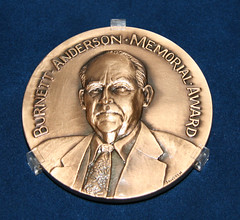 But we've gotten our share of recognition and awards over the years. The highest honor was the 2008 Burnett Anderson Memorial Award for numismatic writing. The award is presented annually to a researcher, author or journalist in recognition of his or her career contributions to numismatics and is judged on the recipient's body of work. Past winners include Q. David Bowers, Beth Deisher, David Harper, R.W. Julian, Clifford Mishler, Eric P. Newman, Edward C. Rochette, Margo Russell and David Alexander.
But we've gotten our share of recognition and awards over the years. The highest honor was the 2008 Burnett Anderson Memorial Award for numismatic writing. The award is presented annually to a researcher, author or journalist in recognition of his or her career contributions to numismatics and is judged on the recipient's body of work. Past winners include Q. David Bowers, Beth Deisher, David Harper, R.W. Julian, Clifford Mishler, Eric P. Newman, Edward C. Rochette, Margo Russell and David Alexander.
It's been a great twelve years. I'm still having fun and enjoying doing it. Keep those great submissions and questions coming!
Wayne Homren
E-Sylum Editor
To read the earlier E-Sylum article, see: MORE ON THE BURNETT ANDERSON MEMORIAL AWARD FOR NUMISMATIC WRITING (www.coinbooks.org/esylum_v11n32a03.html)
To visit the complete E-Sylum Archive, see: www.coinbooks.org/club_nbs_esylum_archive.html
LAKE BOOKS 104TH NUMISMATIC LITERATURE CATALOG AVAILABLE
 Lake Books announces that its 104th mail-bid sale catalog is now available for viewing on its website at
www.lakebooks.com/current.html
.
The sale closes on Tuesday, September 28, 2010 at 5:00 PM (EDT).
Lake Books announces that its 104th mail-bid sale catalog is now available for viewing on its website at
www.lakebooks.com/current.html
.
The sale closes on Tuesday, September 28, 2010 at 5:00 PM (EDT).
The 514-lot sale features selections from the library of Col. William Bain Murray. Bill is a renowned columnist, writer and numismatist. He has researched and written about many of the fine books presented here and the authors have inscribed a number of them to him. Bill has been a careful custodian of these books, so you will find them in excellent condition.
You will find reference material in United States coinage, Ancient and World coins, Paper Money, Tokens and Medals, Exonumia and miscellaneous items relating to numismatics.
Bids may placed via US Mail, email, fax or telephone until the closing time. Good Luck with your bidding.
Fred
Lake Books
6822 22nd Ave. N.
St. Petersburg, FL 33710
727-343-8055 Fax 727-345-3750
www.lakebooks.org
DAVID SKLOW MAIL BID SALE NO. 11 CLOSES OCTOBER 9, 2010
MAIL BID SALE NO. 11 CLOSES OCTOBER 9, 2010
PART THREE OF “THE MASTER OF WOLFEBORO”
Q. DAVID BOWERS RESEARCH LIBRARY
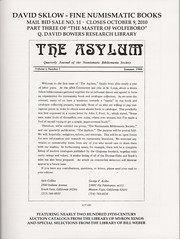 From the research & source library of Q. David Bowers comes over
two-hundred and fifty lots concerning the American Civil War, Maritime
history and ships, references on every type of collectible and the
memorabilia of Abe Kosoff.
From the research & source library of Q. David Bowers comes over
two-hundred and fifty lots concerning the American Civil War, Maritime
history and ships, references on every type of collectible and the
memorabilia of Abe Kosoff.
The sale also features nearly two-hundred, nineteenth century auction catalogs spanning 1855-1875 from the library of numismatic publisher and literature dealer Myron Xenos and special selections from the library of Bill Weber.
Bidders may enter bids by mail, telephone, email or fax. The sale closes at 8pm mountain time, October 9, 2010, however, any bids left on our answering machine or sent by email or fax on or before midnight will be accepted.
Catalogs are available upon request at no charge or can be found on our website.
DAVID SKLOW – FINE NUMISMATIC BOOKS
P.O. BOX 6321
COLORADO SPRINGS, CO 80934
TEL: (719) 302-5686
FAX: (719) 302-4933
finenumismaticbooks@aol.com
www.finenumismaticbooks.com
We are seeking numismatic literature consignments for future auctions. Please contact us for terms.
THE BOOK BAZARRE
A FEW UPCOMING SEPTEMBER 16, 2010 AUCTION HIGHLIGHTSA bound Volume featuring the famous essay by Rev. Henry Christmas on Copper Coinage of the British Colonies in America, Aquila Smith's rare tract on Irish tradesmen's tokens and Richard Sainthill's Defence of the British School of Medal Engravings. Also, the famous 1746 Thomas Pembroke coin plates, featuring the first printed illustrations of American colonial coins.
(614) 414-0855 • df@numislit.com • GFK@numislit.com
MORE COIN BOOKS WITH AN ENCASED COIN OR MEDAL
Last week Alan Roy provided images of two Canadian numismatic publications with embedded coins. This week Brad Karoleff provides images of a couple more - these books have U.S. Bust Half Dollars in them. Thanks! Neat books.
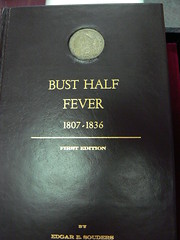

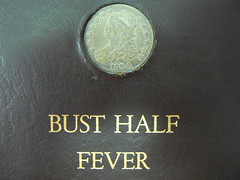
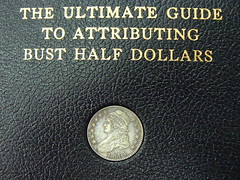
To read the earlier E-Sylum article, see: ANOTHER COIN BOOK WITH AN ENCASED COIN OR MEDAL (www.coinbooks.org/esylum_v13n34a11.html)
NOMINATIONS FOR THE WORST NUMISMATIC BOOK
Dave Hirt writes:
That is an interesting question on the worst numismatic book. In my opinion, none in my library would qualify. However there is one I will suggest. It is the Devonshire sale catalog of March, 1844.
I quote a passage from British Numismatic Auction Catalogues by Harrington E Manville. On page 85, "The Devonshire Catalogue is worthless, upwards of 400 serious errors have been counted in it. Many valuable coins are lotted as false which were probably genuine and sold in lots of 20 & 30 each for nothing --and as no proper opportunity was given to view them, in numerous cases the prices afford no criterion as to their value. It was rather a game of chance or a scramble than a sale."
WOW, what a description!
CONFERENCE REPORT: SAINT-GAUDENS: THE RENAISSANCE OF AMERICAN COINAGE
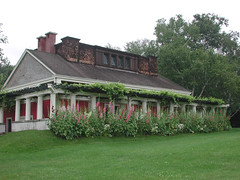 I attended the ANA's post-convention seminar at the Saint-Gaudens National Historic Site in Cornish, New Hampshire. Despite a modest turnout, it was a spectacular success!
I attended the ANA's post-convention seminar at the Saint-Gaudens National Historic Site in Cornish, New Hampshire. Despite a modest turnout, it was a spectacular success!
Most of the participants convened late Sunday afternoon at the nearby Juniper Hill Inn, where we were treated to a tour of the house, followed by a modest buffet dinner. After that, a number of us settled into the Presidential Suite for a post-dinner drink and conversation. For me, it was a nice way to wind down after 11 long days working in Boston!
The next morning, the museum's curator, Dr. Henry J. Duffy, treated us to a long tour of the site's buildings, grounds and sculpture. (Of special numismatic interest among the items displayed were the original plasters for a 1907 Extra High Relief $20 with Arabic Date, and another of St Gaudens' famous Indian Head $20, the pattern formerly known as J-1776.)
After a leisurely box lunch, it was time for two days of “class work”. Henry Duffy filled in some more details about St Gaudens' life and career, and got us to the point where we felt like we truly knew the man. Roger Burdette, whose Renaissance of American Coinage books gave their name to the seminar, spent several hours walking us through the story of Teddy Roosevelt, Augustus St Gaudens and the coins that resulted from their collaboration.
Ute Wartenberg Kagan focused on St Gaudens, the man, as revealed by both his medallic work and his cartoon-illustrated personal correspondence. And John Mercanti, Chief Engraver of the U.S. Mint, gave us an inside look at the Mint, illustrated in part by the story of the creation of the 2009 mini-Ultra.
On Tuesday night, the final night for us at Juniper Hill Inn, we were treated to a superb five course meal, a fitting end to a truly decadent three days of pure-pleasure numismatics. And the next morning, we all headed home.
The instructors, and especially ANA Education Project Manager Susan McMillan, all did a tremendous job, and I heartily encourage everyone to take advantage of the ANA's next “Special Education Event”, should there be one.
And, along those lines, now would be a good time to ask E-Sylum readers for suggestions for future ANA “road trips”. And think hard. I'm ready for another vacation!
To read the earlier E-Sylum article, see: AUGUSTUS SAINT-GAUDENS: THE RENAISSANCE OF AMERICAN COINAGE (www.coinbooks.org/esylum_v13n20a12.html)
COINTELEVISION.COM FEATURES VIDEO HIGHLIGHTS FROM THE ANA CONVENTION

Click here to view free video highlights from the ANA Convention in Boston: cointelevision.com
Video segments include:
ANA President Clifford Mishler, ANA President Discusses state of the ANA and the Boston convention
Edmund Moy, US Mint Director
United States Mint Press Conference Highlights
Beth Deisher, ANA Farran Zerbe Award Winner ANA's highest award winner
Harvey Stack, ANA Lifetime Award Winner
Recognition of the Stack family for a lifetime of service
Ed Reiter, Sr. Editor CoinAge
Market perspective and hobby report
Kerry Tattersall, Director of Marketing
New issues from the Austrian Mint and state of the market
Simon Codrington, International Director, Hugh Wood, Inc.
Insurance for coin dealers and state of the market
Irma Kane, Customer Relations, Teletrade
State of the market and business trends
Michael Sedgwick, Public Relations
Asset Marketing distributes coin issues for the Royal Mint
Wayne Herndon & son, Wizard Coin Supply
State of the market and marketing
Canadian Mint Press Conference
New coin issues
China Mint Press Conference
New coin issues
David Lisot
Executive Producer
972-644-8040
dlisot@cointelevision.com
DICK JOHNSON: FUTURE EXISTENCE OF COINS THREATENED
I had an epiphany standing on the bourse floor of the ANA Boston convention two weeks ago. I had just purchased a pizza for a midday snack. Cost I believe was $7.40. I had a desire to accept the dollars in change, but a feeling came over I did not want the coins in change.
Then it hit me. I was in the midst of the world's largest market place for coin transactions -- millions of dollars changing hands for old and rare coins all round me while I bit into my pizza -- yet somehow I did not want the coins in change for a current cash transaction. I didn't want to be bothered, I was anxious to get back to my bourse area. What if everyone in their daily life had a similar rejection of coins for any reason -- their low value, the inconvenience of waiting for the coins to be counted and handed over, or whatever.
It would be the death of coins. So many factors are moving the world in this direction. The rise in the use first of checks, then credit cards, and now a plethora of payment methods, debt cards, wire transfers, PayPal, internet transfers, and such.
You can recognize a trend here. As collectors and numismatists we should take every measure to insure that coins will exist in the future. That means increasing their usefulness, now and forever. If not and the use of coins will decline -- ultimately to be eliminated entirely -- there will be no coins to collect in the future. That would be the death knell of popular coin collecting and numismatics would become a dead science, perhaps like the study of clay tablets.
As numismatists we must recognize the strengths of coins and their usefulness in small cash transactions. We should recognize this, promote their use, and advocate their benefits in every way.
Here are some suggestions to further the continued existence of coins into the future:
1. Eliminate small denominations. For the United States, eliminate the cent and nickel. The economic value of these coins has diminished. Canada is about ready to abolish their cent coin. Other countries already have abolished one or two coin denominations. To continue their use just infuriates citizens. Let the dime be the smallest coin in circulation. In time the half dollar will be the smallest coin in circulation as our economy advances.
2. Create coins of higher denomination. Strike coins of $5, $10 and $20 denominations. As you eliminate two denominations on the low end, add two denominations on the high end. A study was made once of the optimum number of denominations to facilitate cash transactions -- that number was five. Maybe that is why there are five compartments in cash registers.
3. Resize and correct compositions of new coins. It was brilliant for the U.S. Treasury to make the dollar coin smaller and lighter than the earlier silver dollar. Make the dollar coin size now the standard, make a half dollar and a dime each succeedingly smaller (the quarter will be eliminated once the nickel is gone). Make each new $5, $10 and $20 coin succeeding larger. These high value coins could return to the use of silver without fear the cost of their base metal rising to exceed their face value.
4. Partner with the vending machine industry. Here is an entire industry that exists on the use of coins. It is believed they would welcome larger denomination coins. One report stated that 90% of vending machine problems are the use of paper currency in their machines. If everyone used higher valued coins this could eliminate the acceptance problems of paper currency. But since it is costly to reconfigure every machine, this would have to be a long range project. Learn what the vending machine industry would prefer and have the numismatic field join with them in advocating a unified coin system.
5. The American Numismatic Association should adopt a committee for the study of future coins and partner with other groups to plan for the use and manner of coins in the future. If not, we stand the chance coins could be abolished. Not a pleasant thought for a coin enthusiast.
THE BOOK BAZARRE
PRICED CHAPMAN GEARY SALE FOUND
Bill Rau writes:
One of your readers was asking about a price on lot 640 of the December 13, 1897 Chapman sale, lot 640. This lot sold for $1.00, less than the $1.30 that he found the envelope he found had written on it. The extra 30 cents would have been too much for postage on one lot back then. This buyer probably purchased another lot along with lot 640. I hope this helps.
To read the earlier E-Sylum article, see: QUERY: PRICED CHAPMAN GEARY SALE SOUGHT (www.coinbooks.org/esylum_v13n34a14.html)
5TH KANSAS VOLUNTEER CAVALRY SILVER ENGRAVED PIECE
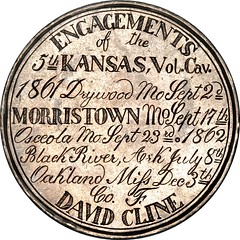
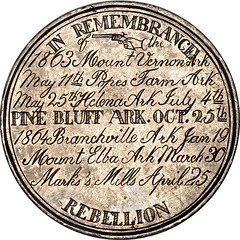
Alan writes:
I regard this as one of the sexiest items available for purchase at the Boston ANA. It joins perhaps a dozen other hand-engraved dollar-size coins from the Civil War that I've gathered for my collection over many decades.
"Inscribed by a jeweler at the behest of the unit's soldier David Cline assigned to the Federal Gov't 's 5th Kansas Volunteer Cavalry Co. F. They fought numerous battles against a violently split pro-slavery/abolitionist Ks population and against raiders around the state's border. This conflict , referred to as the "Kansas Rebellion" (note the word Rebellion in the inscription) and "Bloody Kansas", also involved violent abolitionist/raider John Brown , hanged in Va in 1859. Allegedly in the possession of a Kansas family until one month prior, this was acquired at the 2010 Boston PNG pre-ANA show from well-respected Ky professional numismatist Jonathan Kern and photographed by numismatic photographer extraordinaire Tom Mulvaney at the Boston ANA. "
To view the complete description on NeoCollect, see: 5th Kansas Volunteer Cavalry (www.neocollect.com/item/2701/)
THE BOOK BAZARRE
MORE ON SUSAN GAMBLE'S AIR FORCE COMBAT ACTION MEDAL
Last week's profile of U.S. Mint artist Susan Gamble mentioned that she designed the first Air Force Combat Action Medal. The first six medals were awarded on June 12, 2007.
Joe Boling writes:
You can get an image of the Air Force Combat Action Medal here: en.wikipedia.org/wiki/Air_Force_Combat_Action_Medal . And check out the description there of the difficulty of obtaining the ribbon style used for this medal.
From Wikipedia:
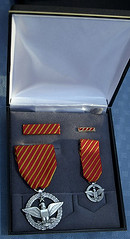 The ribbon's diagonal stripe at first could not be manufactured in the United States; but military medals cannot be manufactured outside the U.S. This design problem was resolved when a mill in Pennsylvania, Bally Ribbon Mills, bought a new loom specifically to weave the diagonal stripe. A Rhode Island firm, Ira Green Inc. in Providence, made the metal parts.[2]
The ribbon's diagonal stripe at first could not be manufactured in the United States; but military medals cannot be manufactured outside the U.S. This design problem was resolved when a mill in Pennsylvania, Bally Ribbon Mills, bought a new loom specifically to weave the diagonal stripe. A Rhode Island firm, Ira Green Inc. in Providence, made the metal parts.[2]
The medal is the only award of the United States military to have a diagonally patterned ribbon, much like various British awards (such as the Distinguished Flying Cross).
To read the earlier E-Sylum article, see: ARTICLE PROFILES U.S. MINT ARTIST SUSAN GAMBLE (www.coinbooks.org/esylum_v13n34a25.html)
MORE ON THE NEW U.S. MINT LOGO
Tom DeLorey writes:
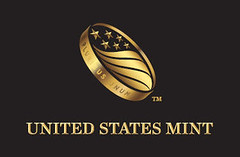 Who designed the Mint's new logo? Chris Cipoletti?
Who designed the Mint's new logo? Chris Cipoletti?
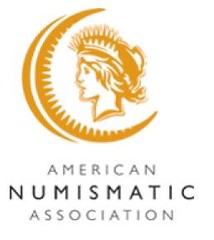 Tom's referring to the former Executive Director of the American Numismatic Association, who presided over a change in the organization's logo that had many members up in arms. The new logo ANA has since been dropped.
-Editor
Tom's referring to the former Executive Director of the American Numismatic Association, who presided over a change in the organization's logo that had many members up in arms. The new logo ANA has since been dropped.
-Editor
Joe Boling writes:
Until the Mint's flack said "flipping in the air," I had no idea that they wanted us to see their new "coin" image that way. But that little TM at the lower right makes it obvious that the coin is NOT flipping in the air - it is tethered to a ponderous system of legalisms, not unlike their stupid (to use your word) efforts to trademark ordinary English phrases describing their programs. That little TM both distracts from and destroys its' effectiveness as a symbol, in my opinion.
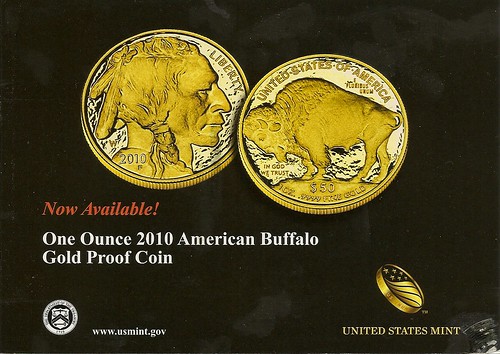
To read the earlier E-Sylum article, see: U.S. MINT UNVEILS NEW LOGO AND MARKETING CAMPAIGN (www.coinbooks.org/esylum_v13n34a18.html)
ARTICLE: COLLECT BOTH OLD AND NEW COIN REFERENCES
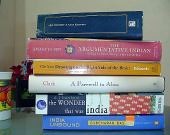 Numismatics is not just about half dollars, cents, or whatever your favorite coin is. Serious numismatists never stop learning, and may find that collecting coin reference books and other materials can be as challenging as completing a favorite series.
Numismatics is not just about half dollars, cents, or whatever your favorite coin is. Serious numismatists never stop learning, and may find that collecting coin reference books and other materials can be as challenging as completing a favorite series.
Many reference books can be found in whatever your favorite series may be. Silver dollar lovers can find books on Morgan, Peace and earlier dollars. Even though the prices may be severely outdated, much of the information is not, and a wealth of knowledge can be found within these books' covers. Collecting these historic titles means you are honoring and connecting with the past. It does not mean that you want to pursue your hobby without the benefit of current information. The latest editions of these or other books can be found at www.ShopNumismaster.com and other online websites.
Those who specialize in early coins can find many volumes on half cents and large cents. Large cent collectors never seem to tire of acquiring knowledge, and any large cent specialist undoubtedly has quite a few reference books in his library. Many early editions of these books are collector's items in their own right.
Many coin magazines, newspapers and other publications have seen print over the years, and sets of these periodicals can be helpful to the serious collector. Check out ads in hobby publications for back issues. It's fun to read the ads in these older issues and see what your favorite coins sold for years ago. Sometimes it's frustrating too!
If you do not have the space to store years' worth of back issues, you could save the issues that contain articles about your favorite series, rare coin, or collecting advice.
Some collectors have made a serious specialty of saving old coin holders and albums. The Library of Coins and Whitman blue folders, and the Classic albums, are collectible and can be picked up for a cheap price. Perhaps your favorite coin dealer has a few of these, or you could find some at a convention. A collector could save albums of his favorite series, or try to find albums to contain more unusual sets, such as type sets of Canada or the Philippines. I once met a large cent collector who wished to own a Whitman Classic album for that series. Some time later, I found one at a hobby shop and mailed it to him.
To read the complete article, see: Collect Both Old and New References (numismaster.com/ta/numis/Article.jsp?ArticleId=13254)
NOTES FROM E-SYLUM READERS: AUGUST 29, 2010
Alan Luedeking writes:
In the Vernon medals review Dick Johnson asked about the meaning of the "(h)" after Dr. Fernando Chao's name. John Adams mentioned "it means 'junior' -- for the word in Spanish."
This is correct, however, the exact meaning of the "(h)" is "hijo" or son, meaning 'junior' in the American English equivalent.
Joe Boling writes:
About the FedEx loss of five coins ten years ago, I can report that registered mail entering the US through JFK is being rifled or stolen. I currently have two claims in process for rifled or never-delivered mail coming in from Europe. Linn's Stamp News has also reported loss of registered mail coming through JFK.
In my opinion, it's better to use regular mail than to call attention to the potential value of a mailpiece by registering it. You can recover only $45.62 in value in international registered mail, unless you have independent insurance. A couple of years ago, the USPS stopped hand-to-hand accountability of international registered mail. Now when a registered piece from overseas enters the US mailstream, it is treated just like any other form of accountable mail - it is accounted for only upon delivery, and if it never arrives at the delivery address, nobody has a clue about where it went astray.
That is certainly NOT the service that a consumer thinks is being pu rchased by using registered mail. And the Postal Service can't understand why it is losing business?
To read the earlier E-Sylum article, see: DEALER FENTON RECOVERS COIN STOLEN TEN YEARS AGO (www.coinbooks.org/esylum_v13n34a26.html)
In the Yahoo Colonial Coins group this week, Ray Williams asked:
I remember when I was young... my Mom had a fur coat. She used to have someone pick it up every Spring to put into "cold storage" for the Summer. I assume this was for preservation.
I recently purchased a beautiful Beaver Pelt, a major export of our colonial times, for use in talks & presentations. Are there any suggestions for keeping it in good condition? I don't want to pay for cold storage, if it exists any more. Put it in plastic and store in the freezer? Dark corner of the basement? Any thoughts are appreciated.
Ron Guth writes:
Another free photo editor is Paint.net. It is very powerful and easy to learn. I use it every day to manage images for PCGS CoinFacts.
John Sallay writes:
I just got back from The Netherlands. While in Haarlem I got to see the numismatic room of the Teylers Museum – AWESOME, and then saw a few cases of nice gold medals in the Van Loon house museum in Amsterdam. I understand that there is also a very good numismatic collection in Leiden, but I didn't have a chance to stop there on this trip.
Andrew Hurle of Australia writes:
Just thought to clarify that those De La Rue patents were English patents, not American. As far as I know they aren't the subject of any existing research so haven't links to provide but I'm happy to send anyone a copy of the patent documents if they wish to follow up.
To read the earlier E-Sylum article, see: BANKNOTE FIRM PATENTED GERMICIDAL AND RADIOACTIVE PAPER (www.coinbooks.org/esylum_v13n34a13.html)
Andrews:
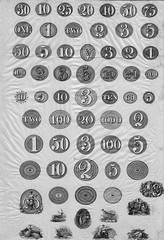 The specimen sheet containing the Audubon grouse I mentioned earlier comes from the numismatic vault in the National Museum of American History in Washington D.C. I discovered it on a scan I had taken while collecting material on geometric lathe configurations there last year. (My field of research is in the abstract, rather than pictorial, elements of monetary design). The sheet seems to be the numerical counterpart to the one owned by Mark Tomasko in the Princeton exhibition.
The specimen sheet containing the Audubon grouse I mentioned earlier comes from the numismatic vault in the National Museum of American History in Washington D.C. I discovered it on a scan I had taken while collecting material on geometric lathe configurations there last year. (My field of research is in the abstract, rather than pictorial, elements of monetary design). The sheet seems to be the numerical counterpart to the one owned by Mark Tomasko in the Princeton exhibition.
To read the earlier E-Sylum article, see: GROUSE HUNTING SEASON: MORE ON AUDUBON'S FIRST ENGRAVED ILLUSTRATION (www.coinbooks.org/esylum_v13n33a11.html)
Regarding the previous week's issue, Joe Boling writes:
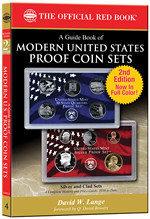 Regarding the Marotta review of David Lange's proof set book: "For 1982, nothing less than Proof 69 Ultra Cameo is worth tallying." Why so? Surely that's not all that the mint delivered that year. Is the book only for dedicated collectors who have searched out a PF69UC set? Why should not the holder of a set that has been sitting on a shelf since it arrived in 1982, and is merely shiny, not be able to learn its value - even if it's only 91 cents?
Regarding the Marotta review of David Lange's proof set book: "For 1982, nothing less than Proof 69 Ultra Cameo is worth tallying." Why so? Surely that's not all that the mint delivered that year. Is the book only for dedicated collectors who have searched out a PF69UC set? Why should not the holder of a set that has been sitting on a shelf since it arrived in 1982, and is merely shiny, not be able to learn its value - even if it's only 91 cents?
To read the earlier E-Sylum article, see: BOOK REVIEW: MODERN UNITED STATES PROOF COIN SETS, SECOND EDITION (www.coinbooks.org/esylum_v13n33a04.html)
Joe adds:
About the Tensho oban gifted by the "city" of Toyokoro, Japan, to the "sister city" of Summerland, BC: Toyokoro is an agricultural town of fewer than 5000 residents in southeastern Hokkaido. Summerland is a bit larger, at 11,000, in southeastern BC. I sincerely doubt that the oban is an original, which would have a market value starting at about $150,000.
To read the earlier E-Sylum article, see: TOYOKORO, JAPAN GIVES GOLD OBAN COIN TO SISTER CITY (www.coinbooks.org/esylum_v13n33a17.html)
MORE ON THE ROOSEVELT UNIVERSITY COURSE IN NUMISMATICS
I was perhaps the youngest member of this class (being a 16-year-old high-school junior in Chicago) back when it was offered in the Fall of 1965. The class was fairly widely publicized in advance, and each student had the choice of taking it either for credit (1 hour) if you wrote a paper, I believe, or it could be audited (like I took it) for no credit. The course met one night a week (I want to say Wednesdays at 7 pm to 8 pm, but my memory may be rusty after 45 years).
I would guess there were about 12-15 students enrolled. (I think there were more present the first night, including university officials and the class sponsors.) There was a different guest lecturer for each class. Many if not most of the lecturers brought handout materials or used a slide projector or something to help illustrate. It was a single semester or single quarter course (that is, it met about 10 or 15 times in total).
Roosevelt is a private university, but the cost (for a 1 hour class) was not prohibitive back then, or I wouldn't have been able to do it. The topics were wide-ranging, although even by then I had decided to specialize in town anniversary tokens and medals, and I recollect there was not too much offered on medals in general and nothing on my sub-specialty.
I also recollect that mention was made at the class about The Chicago Coin Club, which I joined and was active in for 5 or so years before I started law school. I did not attend Roosevelt for college or law school, but did receive at the end of the course a certificate of completion (a nice touch) which I long ago misplaced or discarded. I took copious notes, like a good student should, and have misplaced or disposed of them also, like almost all students do.
If the exact date the course started was September 29, then I'm pretty certain that Yom Kippur started on September 28 that year, as the class began on the Evening that completed the day of Yom Kippur of 1965. The first class caused me a great moral dilemma. I had until then (and every year since) strictly observed the Jewish Holiday (Holy of Holy Days), which meant fasting from sundown (the night before our class started) to sundown (which was around or shortly after our first class would start).
Unfortunately, allowing for travel time from home to get to that first class, I would have to break the fast an hour or two beforehand if I wanted to eat first. It's really tough for a skinny 16-year-old to fast the extra 3 hours until I got home! I really didn't want to miss that first class (my first day of college, literally), so I ended up eating at home early and not going back to the synagogue for concluding prayers that evening. I have been repenting from that transgression ever since 1965 and obviously still have strong feelings of guilt to remember all that!
But I digress. The class was attended by several real college students at Roosevelt (who for all I know were serious history majors, numismatists or both) and some adults (post-college age), most likely like me from the Chicago area. I was extremely impressed by the level of scholarship that was necessary to really be knowledgeable on coins and related items. The class was not repeated or extended to a second level, for reasons that I do not know.
Roosevelt University is located in downtown Chicago, in the national landmark building designed by Louis Sullivan which also houses the breath-taking Auditorium Theater. The ANA Convention (in 1965 or 1966) was held 1 block south (across the street) at the old Pick-Congress Hotel, if I remember correctly, which was my first ANA Convention. Like the Roosevelt U. Numismatics Course medal struck by The Franklin Mint (and sent to each of us who attended the class at no cost - a nice bonus!) which George mentions, that Chicago ANA Convention medal featuring Abe Lincoln pops up on eBay from time to time.
I'd be interested to hear from others involved with the class - either as students, presenters or supporters.
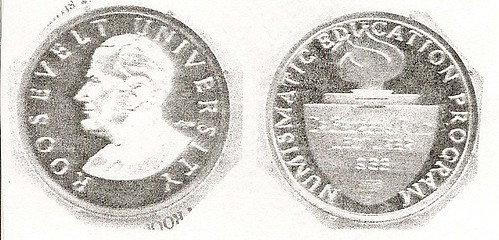


Sheldon adds:
I just read Ken Bressett's recollections (from the participants' side) in the August 22 E-Sylum and it brings back some additional memories. Also, it points out a few errors in my memory - I wrongly stated there was no 2nd course (I don't recollect it and probably didn't take it). I do remember that the large majority of lecturers came a long ways to teach that one night lecture.
Kudos to those like Ken who made serious efforts to launch a college-credit level program at a 4-year university, and kudos to The Franklin Mint for issuing the medal (and presenting it to participants and presenters alike!).
To read the earlier E-Sylum article, see: THE ROOSEVELT UNIVERSITY COURSE IN NUMISMATICS (www.coinbooks.org/esylum_v13n34a17.html)
THE 1966 ANA PNG ARBITRATION HEARING AND ROOSEVELT UNIVERSITY
The day before the A.N.A. convention began in August 1966, Eric P. Newman was awarded one of two gold medals authorized by the United States government, for his past research works and participation in a numismatic course titled “Advancement of the Science of Numismatics” organized in part by Art Kagin and sponsored by the Professional Numismatists Guild at Roosevelt University in Chicago. The other gold medal went to the acting president of Roosevelt University, Rolf Weil (see The Numismatist, November 1966, p.1437).
There were hundreds of guests present for this event with many being members of the A.N.A. The idea for the classes was to make numismatic courses available in institutions of higher learning throughout the country. Leo Young, the President of P.N.G., made the presentation at the P.N.G. banquet held on August 15th across the street from Roosevelt University. This lofty program ran aground a few days later and was never revived due in part to the greatest controversy in American numismatics.
At a hearing convened towards the end of the 1966 A.N.A. convention, Eric P. Newman, representing the Eric P. Newman Numismatic Educational Society (founded in 1958), presented a report titled An Inquiry into the Authentication of a Hoard of $20 United States Assay Office Gold Pieces. He began with “avoiding the use of names of individuals to the extent that a full disclosure of facts will not be adversely affected.” This was a very commendable attempt by Newman to keep things from getting personal; however, it didn't work because of Ford's response the following year.
The Newman findings dealt with the physical evidence found on the coins themselves. Since names were never mentioned, the coins in question were referred to as “Humbert Associate Source” based on the earlier Ford story in The Numismatist. As outlined by Newman in 1966, he had been collecting and studying American coins and paper money for 45 years. His published works covered “counterfeits, reproductions, imitations, forgeries, alterations, and fantasies”. He had often lectured on false coins. Knowing full well the implications of what he was presenting, he wrote, “The importance of a correct determination of the question cannot be underestimated, since it relates not only to the Garland coin under review and to other numismatic items in the hands of collectors and dealers but to the future of numismatics.”
The evidence that these 1853 U.S.A.O.G. coins were false was examined in great detail. Newman had correctly figured things out; but regrettably, was never given any support or credibility and acknowledgement by those involved in the commercial aspect of American numismatics. He asked for a thorough investigation into the situation, and that a solution would be found to cope with the menace of modern forgeries and fantasies. “Every lawful pressure should be used by numismatists and their organizations to require that all coins, dies, hubs, punches, bars, trials, molds, and stampings emanating from the Humbert Associate Source (later called the “Franklin Hoard” by Ford) be turned-in to the A.N.A., the A.N.S., or other permanent impartial organizations for permanent mutilation after settlement by sellers of any proper refunds to purchasers.”
Franklin was never questioned about anything, even by the P.N.G. panel consisting of Lester Merkin, Ronnie Carr, and Herbert Bergen (which was originally convened to address the question of genuineness – not the coin's condition or grade), and he always remained silent (this may have been because Ford insisted that it be that way). After presenting his findings to the P.N.G. board, Newman asked if he could have Franklin reveal his sources when he was called as a witness. Ford interrupted and said that professional coin dealers do not reveal their sources under client confidentiality. Newman wasn't asking Ford, but Franklin, who was not an acknowledged coin dealer at the time.
Since it was late in the day, the panel decided to end the session, but said Newman would be allowed to ask Franklin to name names the next day. Not surprisingly, Franklin left town that evening (August 19, 1966). He was not present for the session the following day; therefore, Franklin's sources have remained unknown and only speculated upon.
Ford did all the talking, while Franklin never validated or authenticated anything; and since he was never made to reveal his sources, no specific names were ever provided by him. This is called the “third party close” in sales lingo. This was most convenient for all parties involved. As Ford himself states in his 1967 P.N.G. document on page 7, “We had a good thing going”.
Shortly after this 1966 P.N.G. hearing, Lester Merkin resigned from the Professional Numismatists Guild. He had not allowed the panel to make a unanimous determination on the genuineness of the pieces. Of course, that was his role since he had been selected by the defense.
Regarding his resignation Merkin later said, “I left because I had an argument about several things, and I figured that either I'm very wrong or I shouldn't be butting in. I figured the best thing for me to do was just leave…I wanted things done a certain way. My way was not wrong. I was right, but I didn't understand politics. That's something I've never understood.” (see Legacy, spring 1989, p.65).
If Merkin had agreed with Ronnie Carr and Herbert Bergen that the pieces were not genuine, the entire issue would have been resolved at that point. Merkin, a musician by trade, had been in the coin business about 6 years, having established a coin shop in New York City where New Netherlands (Ford) and Stack's were located, and had been for a long time.
Reportedly, the tape recording made at the 1966 P.N.G. hearing disappeared or could not be found; and, apparently, there had been no written transcript made of the August 1966 hearing. Four months later, on December, 6, 1966, Carr, as Chairman, writes to Ford asking for photographs of his 3 U.S.A.O.G. pieces and the two electro cast copies that were made for Ford by Franklin in the 1950s.
As seen in his December 12, 1966, letter to Carr, Ford was still trying to get a written transcript of what transpired in August. Therefore, with the tape missing, all of the evidence presented in 1966 was now “lost”. This telling letter closes with Ford accurately relating that Franklin did not create the 1853 U.S.A.O.G. “Proof” $20s, and that he was not duped by Franklin, even though according to Ford, he tried twice to do so.
The November 1966 issue of The Numismatist has a photo of Eric Newman getting his gold medal on p1437. Could someone send us an image of the photo? My issue is in a bound volume and is difficult to scan. -Editor
THE BOOK BAZARRE
DONATED MEDAL COMMEMORATES 1758 CAPTURE OF LOUISBOURG FORTRESS

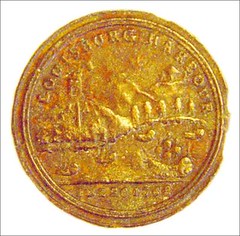
Doug Shand carried something very special with him as he walked the grounds of this 18th-century fortress last week.
The Shag Harbour, Shelburne County, man came to take part in the voluntary public archeology dig but to also make a donation to the Fortress of Louisbourg National Historic Site, a commemorative medal marking the 1758 capture of the fortress.
Archeologists were agog when he presented the old medal to them.
"It's considered rare and we didn't have one in our collection," said Germaine LeMoine, a Parks Canada spokeswoman.
For his part, Shand said as a coin collector, he has a particular interest in the period from 1600 to 1760.
"But, most especially, I'm interested in anything having to do with Louisbourg," said Shand, who is area director of the Royal Canadian Numismatic Association.
"This was a duplicate in my collection that I picked up at an auction in California."
The coin features the image of Admiral Edward Boscawen of England with the inscription ADML Boscawen Took Cape Breton and a depiction of ships in Louisbourg Harbour.
Fortress Louisbourg will house the medal in its permanent collection.
To read the complete article, see: Rare medal donated to Fortress (thechronicleherald.ca/NovaScotia/1198223.html)
NEW ZEALAND MEDAL THIEF SENTENCED TO PRISON
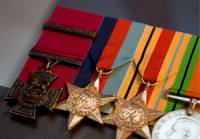 Waiouru medal thief James Joseph Kapa wiped tears from his eyes today as he was sent to prison for six years for a crime which shocked the nation.
Waiouru medal thief James Joseph Kapa wiped tears from his eyes today as he was sent to prison for six years for a crime which shocked the nation.
The tears meant nothing to the director of the Waiouru Army Museum or to the daughter of the country's greatest war hero, Charles Upham.
"This crime tore the heart out of every New Zealander apart from the criminals who committed it," museum director Colonel (retired) Ray Seymour said in an emotional address to Judge Graham Hubble in Auckland District Court.
He was reading a victim impact report shortly before Kapa was jailed for six years on one charge of burglary after he and Ronald van Wakeren broke into the museum at Waiouru in December, 2007, and stole 96 medals, including the Victoria Cross and bar won by Charles Upham, the only combat soldier in the world to have twice won the Commonwealth's highest bravery award.
In court today, Col Seymour said "the nation was quite rightly so angry anyone could have had the audacity to commit such a heinous crime".
During the sentencing crown prosecutor Deb Bell said the medals had been valued at $5.5 million but the crown believed they were priceless and of immense significance to all New Zealanders.
Judge Hubble told Kapa the medals were New Zealand icons and the sentencing of Kapa would be a deterrent against people who "meddle with New Zealand icons".
To read the complete article, see: Army Medal Theft `Tore The Heart Out' Of A Nation (www.voxy.co.nz/national/army-medal-theft-tore-heart-out039-nation/5/60347)
INDIAN WAR MEDAL OF HONOR DISPLAYED AT PITTSBURGH MUSEUM
Sgt. John Kirkwood, a Pittsburgh native, boosted military morale by rescuing a fellow officer after the Army's 3rd Cavalry attacked an Indian village in Slim Buttes in the northwest corner of South Dakota.
On Sept. 9, 1876, during a pre-dawn raid on 35 Indian lodges, Sgt. Kirkwood saved Lt. Adolphus H. Von Luettwitz, who was wounded in the kneecap and fell from his horse.
As arrows flew and guns blazed, the 25-year-old sergeant carried his injured lieutenant from the battlefield to safety atop a ridge. With the help of another soldier, Sgt. Kirkwood attacked and drove Sioux Indians from their hiding place in a ravine.
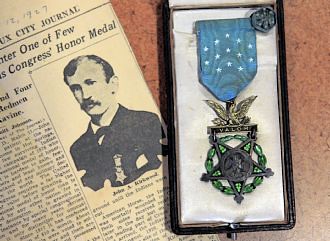
Betty Willey, 84, of Asbury Villas in Mt. Lebanon, relived her uncle's military career when she took a field trip in April to Soldiers & Sailors Memorial Hall in Oakland. By chance, she rode in her wheelchair up to a poster recounting Sgt. Kirkwood's bravery, for which he received the Medal of Honor -- the nation's highest military award for valor against an enemy.
After she casually mentioned the outing, her niece and nephew -- siblings Melinda and Don Willey -- visited Michael Kraus, the museum's curator, to see for themselves what was on public view about the man who figured in their extended family's lore. Those visits have prompted Sgt. Kirkwood's descendants to permit his medal and other relics of his service to be included in a new exhibit planned for the museum.
"You would have thought the guy had won the lottery," Melinda Willey said of the earlier meeting with Mr. Kraus. "He took us and showed us the display. We realized, at that point, that we had something very valuable and very pertinent to Pittsburgh history."
The Willeys are donating Sgt. Kirkwood's Medal of Honor to the memorial because he was born in the region and already is included in the museum's Hall of Valor.
"This medal is so rare. It's the top dog," Mr. Kraus said, adding that few of them were awarded during the Indian Wars. It is illegal to buy or sell Medals of Honor.
"Its monetary value is zero. Its historic value is huge," Mr. Kraus said.
To read the complete article, see: Local soldier's rare Medal of Honor set for museum display (www.post-gazette.com/pg/10241/1083481-455.stm)
DOLLAR REDE$IGN PROJECT UPDATE
A recent entry has sparked a lot of political debate. I didn't publish the design last week, but I can't resist now that the submitters have been called “a bunch of tea-drinking fancy pants Limeys.” -Editor
As one may have expected, design company Dowling Duncan's imaginative currency redesign for Richard Smith's Dollar Rede$ign Project has sparked some heated reactions.
... a blog called Southern Beale sarcastically referred to [the] half-British company as “a bunch of tea-drinking fancy pants Limeys.”
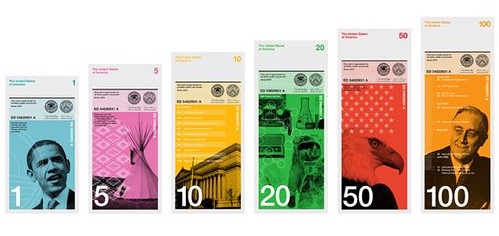
The designers told the UK's Creative Review that the controversy came as a surprise. “We wanted to challenge people's perceptions about what the dollar should be or could be, but putting Obama on the $1 bill seems to be the major talking point.”
There's currently no word on Obama's reaction to the design. “[W]e've tried desperately to get to him but as you can imagine he is a hard man to reach,” says Dowling Duncan. “We've been told by some good sources that he would have seen it, but for him to comment on it would really ignite the debate.”
Besides the “partisan” messages on some the bills, the redesign offers some pragmatic improvements. ”When we researched how notes are used we realized people tend to handle and deal with money vertically rather than horizontally,” the studio explained. “You tend to hold a wallet or purse vertically when searching for notes. The majority of people hand over notes vertically when making purchases. All machines accept notes vertically. Therefore a vertical note makes more sense.” The notes are also sized differently based on their value, like the Euro.
Dowling Duncan's design currently has the most votes in Smith's contest, which will give an Apple iPad as a grand prize.
To read the complete article, see: Reactions to Dowling Duncan's Dollar Redesign (flavorwire.com/114088/reactions-to-dowling-duncans-dollar-redesign)

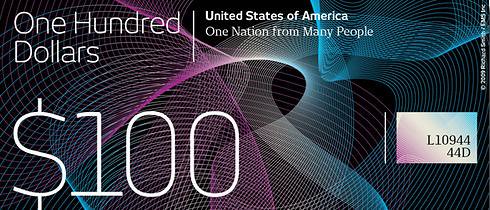
To read the complete article, see: Dollar ReDe$ign Project (richardsmith.posterous.com/tag/dollarredeign)
BILL DANA AND THE MERCURY ASTRONAUT SHORT SNORTER
One lot in Regency Superior's upcoming October space sale should appeal to space memorabilia collectors, autograph hunters... and perhaps even numismatists.
The item in question is a an original "Short Snorter" $1 bill signed by each of the original Mercury Astronauts: Alan Shepard (later a Moonwalker with Apollo 15), Gus Grissom, John Glenn, Scott Carpenter, Wally Schirra, Gordon Cooper and Deke Slayton.

And beside them is the autograph of Bill Dana - one of the best-loved funnymen in America and also the unofficial "8th Mercury astronaut".
Comedian Dana was best-known for his comic creation, the heavily-accented Mexican character named José Jiménez, back in the 1960s.
When America's Mercury Astronauts adopted "José the Astronaut" as their mascot, Dana was chosen to speak the first words ever broadcast to an American entering space.
"Okay José, you're on your way," were Dana's immortal words which cemented his place in space exploration history.
Bill Dana later went on to join the advisory board of the Astronaut Scholarship Foundation, and has been acknowledged by the Smithsonian Air and Space Museum.
He was also inducted as the official Eighth Mercury Astronaut at the United States Astronaut Hall of Fame at Titusville, Florida.
Appearing in the auction with an estimate of $5,000-7,000 (bids open at $2,500) this is a rare chance for investors to acquire the signature of one of America's funniest men, alongside seven of its bravest and most intrepid.
To read the complete article, see: Banknote signed by comedian and 'Mercury astronaut' Bill Dana could bring $5,000 (www.paulfrasercollectibles.com/section.asp?catid=73&docid=4304)
1736 COIN FOUND BY TENNESSEE STREET SWEEPERS
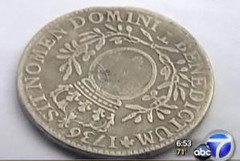 A couple of street sweepers made a rare find in Tennessee when they picked up a coin.
A couple of street sweepers made a rare find in Tennessee when they picked up a coin.
The two men said they often pick up coins that have been tossed on the ground, but the one they found on Wednesday was different than the rest.
"I hollered, 'Albert look here what I found!' And we looked at it, it's a 1736 silver coin," said Jonathan Bowman.
Pictures and measurements of the coin have been sent to the Smithsonian to see if the coin really is a 1736 French coin.
If the coin is authentic, the rare item dates back to the time of King Louis XV. He was king of France during the French and Indian War, when French military men were in the United States.
To read the complete article, see: Rare 1730s coin found on street in Tenn. (abclocal.go.com/kabc/story?section=news/bizarre&id=7631422)
ANCIENT COIN FOUND IN ROMAN-ERA MOSAIC
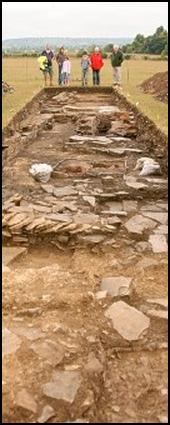 A Roman villa that lay undisturbed for more than 1,000 years is finally giving up its secrets.
A Roman villa that lay undisturbed for more than 1,000 years is finally giving up its secrets.
Archaeologists believe a site just uncovered at Butleigh, near Glastonbury, helps to fill in some of the missing gaps of Somerset's history.
For centuries the piece of land, known as Beggar's Field, has seen little more activity than the pasturing of cattle.
With permission of the tenant farmer Richard Chaddock, Absolute Archaeology has recently completed its second training dig of the site, uncovering a late Roman villa that shows evidence of continual occupation into the so-called "Dark Ages".
There has been a wealth of finds, from rare Roman coins to pieces of Roman pottery, a quern stone, and a limited amount of metalwork.
But the most exciting discoveries uncovered in the trench included foundations of massive walls, an industrial hearth, a corn-drier and parts of mosaic floors later paved over with flagstones.
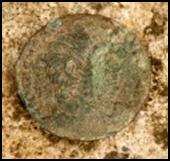 The very bottom layer – the earliest sign of occupation of this building – is a mosaic floor which, helpfully, had within its membrane a Roman coin dedicated to the emperor Magnentius who ruled until 353AD.
The very bottom layer – the earliest sign of occupation of this building – is a mosaic floor which, helpfully, had within its membrane a Roman coin dedicated to the emperor Magnentius who ruled until 353AD.
Paul said: "The evidence of the site indicates a number of different uses of the building over a substantial amount of time. We have several layers of floors on top of each other.
"What we have here is a high-status late-Roman building with mosaics.
To read the complete article, see:
Secrets of Roman villa's past revealed after more than 1,000 years
(www.thisissomerset.co.uk/news/Secrets-Roman-villa
-s-past-revealed/article-2571645-detail/article.html)
FEATURED WEB PAGE: STIEFF COMPANY LUCKY PIECES
This week's Featured Web Page is suggested by Kay O. Freeman. Given Russ Sears' earlier discussions of the Judge Gorter medal and J. Jenkins Sons, she sent this link to a page from the site of another Baltimore area firm, the Steiff silver company. The page describes the company's Lucky Piece tokens and other souvenirs.
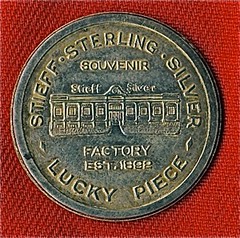
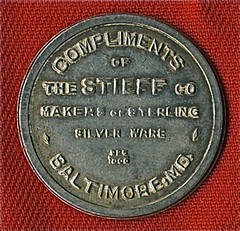
When Stieff opened the new factory at 800 Wyman Park Driveway in Hamden, many people wanted to come and tour the building. Stieff was happy to give tours and give a small gift to the visitors.
In the beginning people received a large Sterling Silver “Lucky Piece” the size of Fifty Cent coin. Later these tokens were reduced in size to that of a quarter sized coin.
When the factory opened in 1925, Sterling Silver “Lucky Pieces” were given out to people that toured the new building.
www.thestieffcompany.com/The_Stieff_Company/
Stieff_Lucky_Pieces_and_Spoon_Pins.html

